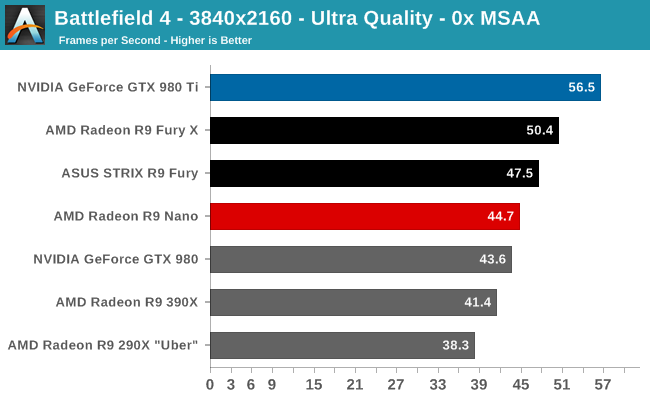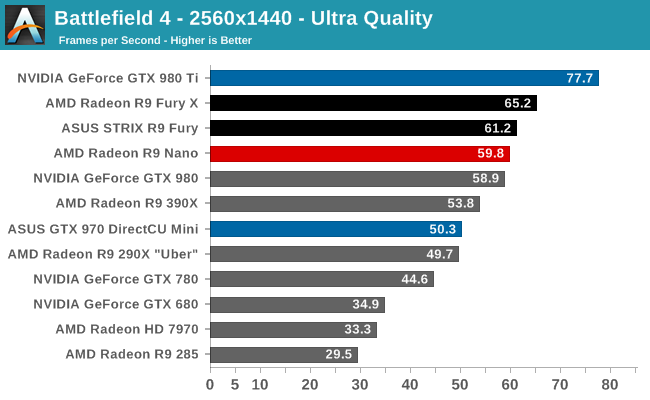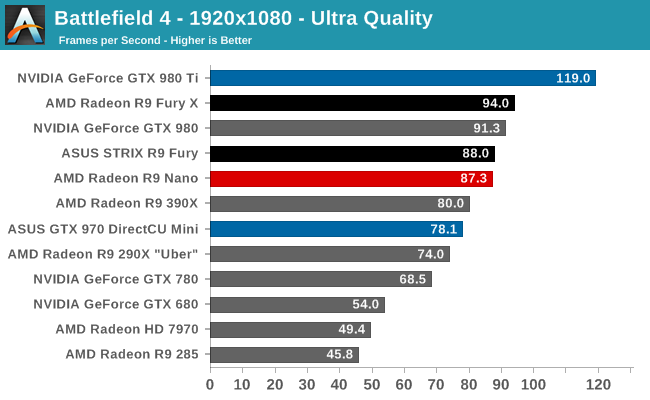The AMD Radeon R9 Nano Review: The Power of Size
by Ryan Smith on September 10, 2015 8:00 AM ESTBattlefield 4
Kicking off our benchmark suite is Battlefield 4, DICE’s 2013 multiplayer military shooter. After a rocky start, Battlefield 4 has since become a challenging game in its own right and a showcase title for low-level graphics APIs. As these benchmarks are from single player mode, based on our experiences our rule of thumb here is that multiplayer framerates will dip to half our single player framerates, which means a card needs to be able to average at least 60fps if it’s to be able to hold up in multiplayer.




Like the other Fiji cards, AMD is promoting the R9 Nano in part on its 4K capabilities. And while we disagree that this card is suitable for 4K gaming based on its sub-Fury performance, we’re including 4K results anyhow to serve as a point of comparison.
In any case Battlefield 4 is often a good indicator of general card performance, and for the R9 Nano this is no exception. What we find is that the R9 Nano trails the other Fury cards in all cases. However to our initial surprise, the R9 Nano sticks rather close to the R9 Fury. The petite powerhouse trails the R9 Fury by only 1-6%, which for the record is a smaller gap than we were expecting.
While the R9 Nano packs a full Fiji GPU, AMD has to pull back on clockspeeds to hit their power targets; in the case of Battlefield 4 this is an average clockspeed of just 879MHz at 2560x1440. Given this we had been expecting the R9 Nano to deliver around 85-90% of the performance of the R9 Fury (and about 80% of the R9 Fury X), based on the assumption that average clockspeeds would be closer to 800MHz. So the fact that the R9 Nano starts off as close to the R9 Fury as it does – even if it’s still trailing it – is a pleasant surprise.
Otherwise with performance still clearly occupying a position as a “3rd tier” Fiji card, I’m not sure if anything about these results should be surprising. On a price/performance basis AMD is not intending to be competitive with other $650 cards, so the R9 Fury X and GTX 980 Ti are of course on the top of the heap. What you get instead is a card that delivers around 90% of R9 Fury X’s performance in BF4 with much less power consumption.
Moving on, compared to the lower power and smaller cards, the R9 Nano is as expected a clean sweep. Demonstrating the virtues of a wide and lower clocked processor’s ability to deliver strong performance without requiring extreme power, everything from the R9 285 to the GTX 980 trails the R9 Nano here. Compared to the GTX 970 Mini in particular, the R9 Nano is 12-26% faster depending on the resolution.
The one potential problem here for the R9 Nano is the GTX 980. Though not a Mini-ITX card, the GTX 980’s power consumption is going to be fairly close to the R9 Nano’s, definitely more so than GTX 970’s. From a power efficiency standpoint it’s the GTX 980 that poses the greatest challenge to the R9 Nano, and while it’s ahead of the GTX 980 in this case at 2560x1440 and higher, it’s a sign that AMD should be worried about what could happen if an NVIDIA partner produced a Mini-ITX GTX 980.










284 Comments
View All Comments
extide - Thursday, September 10, 2015 - link
Top gear ran every car they tested around the same track didn't they? Also you will find tins for the ring on plenty of stuff that isn't as fast as a 911 GT3 RS. Plus the 4k numbers ARE useful to see how the performance scales.extide - Thursday, September 10, 2015 - link
tins = times *Ryan Smith - Thursday, September 10, 2015 - link
I don't believe the quality compromises are worth it, nor is playing at 30fps on a $650 card. However I know other people disagree with me, which is why I include the data.Daniel Egger - Friday, September 11, 2015 - link
The data is exactly what I'd like to see but your comment as the reason why you provided the data in at all is quite off-putting, non-sensical and does not belong there:The graphs about that sentence show that it is only 3 FPS slower than the Fury and even faster than the GTX 980, so either the comment should be that neither card is recommended for Battlefield in Ultra Quality 4k (although I do not necessarily why, the shown figures are way above "30fps" ...) and/or save that remark for your final conclusions.
extide - Thursday, September 10, 2015 - link
In a few months, when AMD finally has enough supply of these things, and they can drop the prices, the while Fury line will be amazing!! They are NOT bad products, they just have bad prices, right now, and they will until the supply issues are resolved. If they can't keep em in stock at these prices, then why lower them? No way.But yeah, in 3-4 months or so, I bet we see some pretty big price drops on all of these babies. Good times a comin!
Refuge - Thursday, September 10, 2015 - link
I agree that the price is what makes these gems look like crap.But I also don't believe a price drop big enough to make them look like the gems they are will be in our future.
wintermute000 - Thursday, September 10, 2015 - link
That, and confirmed performance on real AAA DX12 titlesD. Lister - Saturday, September 12, 2015 - link
Really? What else can you see in the magic crystal ball? Would we ever colonize Mars? Is a cure for cancer coming anytime soon? Speak man!itproflorida - Thursday, September 10, 2015 - link
These benchmarks are bogus, my single 970 can do BF campaign @ 4k Ultra no AA, 45 -64 fps avg 57fps. SLI 62 -90fps campaign.nikaldro - Thursday, September 10, 2015 - link
Multi-player, duh.